2014 MITSUBISHI OUTLANDER SPORT child restraint
[x] Cancel search: child restraintPage 95 of 388
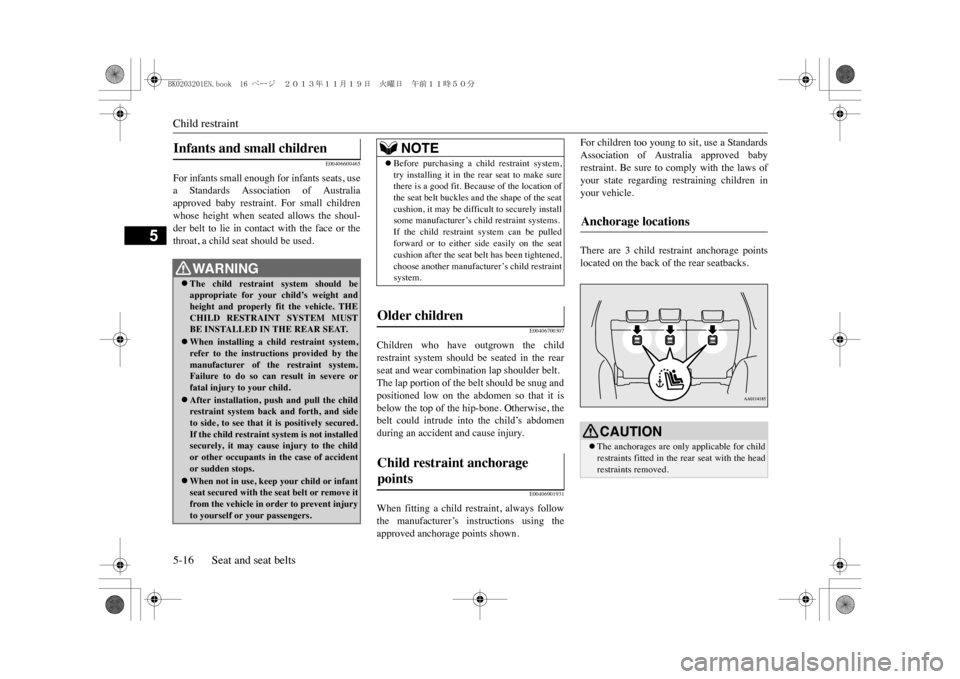
Child restraint5-16 Seat and seat belts
5
E00406600465
For infants small enough for infants seats, usea Standards Association of Australiaapproved baby restraint. For small childrenwhose height when seated allows the shoul-der belt to lie in contact with the face or thethroat, a child seat should be used.
E00406700307
Children who have outgrown the childrestraint system should be seated in the rearseat and wear combination lap shoulder belt.The lap portion of the belt should be snug andpositioned low on the abdomen so that it isbelow the top of the hip-bone. Otherwise, thebelt could intrude into the child’s abdomenduring an accident and cause injury.
E00406901931
When fitting a child restraint, always followthe manufacturer’s instructions using theapproved anchorage points shown.
For children too young to sit, use a StandardsAssociation of Australia approved babyrestraint. Be sure to comply with the laws ofyour state regarding restraining children inyour vehicle.There are 3 child restraint anchorage pointslocated on the back of the rear seatbacks.
Infants and small children
WA R N I N G�zThe child restraint system should beappropriate for your
child’s weight and
height and properly fit the vehicle. THECHILD RESTRAINT SYSTEM MUSTBE INSTALLED IN THE REAR SEAT.�zWhen installing a child restraint system,refer to the instructions provided by themanufacturer of the restraint system.Failure to do so can result in severe orfatal injury to your child.�zAfter installation, push and pull the childrestraint system back and forth, and sideto side, to see that it is positively secured.If the child restraint system is not installedsecurely, it may cause injury to the childor other occupants in the case of accidentor sudden stops.�zWhen not in use, keep your child or infantseat secured with the seat belt or remove itfrom the vehicle in order to prevent injuryto yourself or
your passengers.
NOTE
�zBefore purchasing a child restraint system,try installing it in the rear seat to make surethere is a good fit. Because of the location ofthe seat belt buckles and the shape of the seatcushion, it may be difficult to securely installsome manufacturer’s child restraint systems.If the child restraint system can be pulledforward or to either side easily on the seatcushion after the seat belt has been tightened,choose another manufacturer’s child restraintsystem.
Older children Child restraint anchorage points
Anchorage locations
CAUTION�zThe anchorages are only applicable for childrestraints fitted in the rear seat with the headrestraints removed.
BK0203201EN.book 16 ページ 2013年11月19日 火曜日 午前11時50分
Page 96 of 388
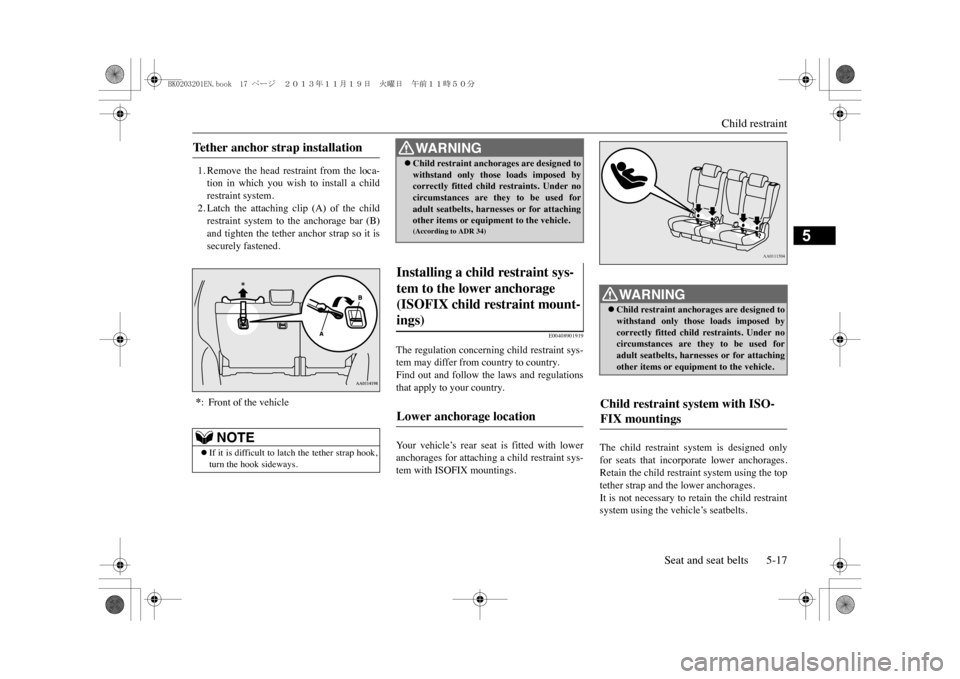
Child restraint
Seat and seat belts 5-17
5
1. Remove the head restraint from the loca-tion in which you wish to install a childrestraint system.2. Latch the attaching clip (A) of the childrestraint system to the anchorage bar (B)and tighten the tether anchor strap so it issecurely fastened.
E00408901919
The regulation concerning child restraint sys-tem may differ from country to country.Find out and follow the laws and regulationsthat apply to your country.Yo u r v e h i c l e ’s r e a r s e a t i s f i t t e d w i t h l o w e ranchorages for attaching a child restraint sys-tem with ISOFIX mountings.
The child restraint system is designed onlyfor seats that incorporate lower anchorages.Retain the child restrain
t system using the top
tether strap and the lower anchorages.It is not necessary to retain the child restraintsystem using the vehicle’s seatbelts.
Te t h e r a n c h o r s t r a p i n s t a l l a t i o n *: Front of the vehicle
NOTE
�zIf it is difficult to latch the tether strap hook,turn the hook sideways.
WA R N I N G�zChild restraint anchorages are designed towithstand only those loads imposed bycorrectly fitted child restraints. Under nocircumstances are they to be used foradult seatbelts, harnesses or for attachingother items or equipment to the vehicle.(According to ADR 34)
Installing a child restraint sys-tem to the lower anchorage (ISOFIX child restraint mount-ings) Lower anchorage location
WA R N I N G�zChild restraint anchorages are designed towithstand only those loads imposed bycorrectly fitted child restraints. Under nocircumstances are they to be used foradult seatbelts, harnesses or for attachingother items or equipment to the vehicle.
Child restraint system with ISO-FIX mountings
AA0111504
BK0203201EN.book 17 ページ 2013年11月19日 火曜日 午前11時50分
Page 97 of 388
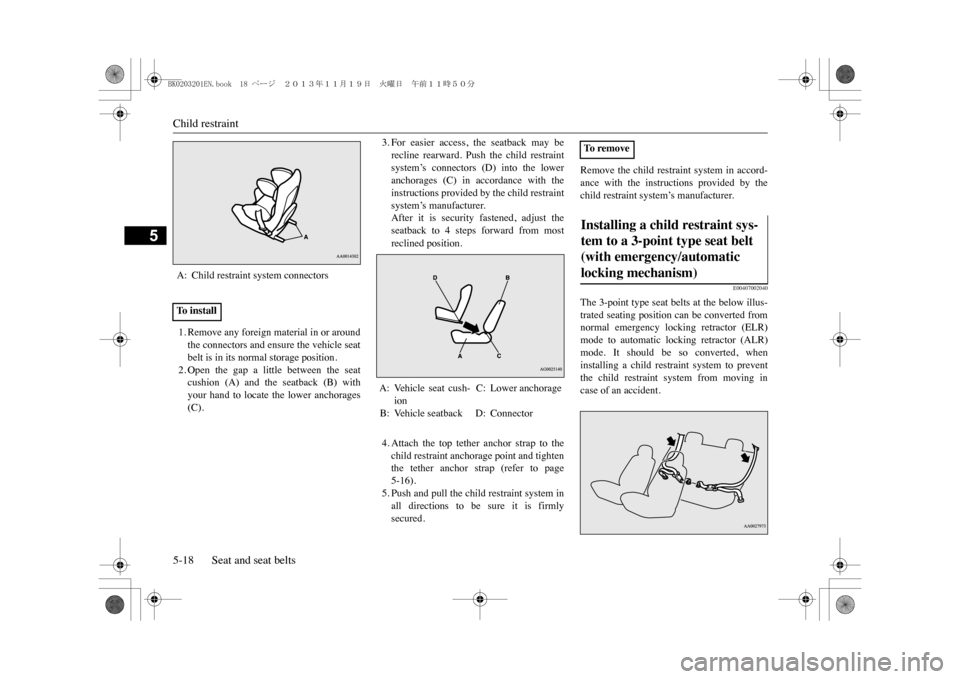
Child restraint5-18 Seat and seat belts
5
1. Remove any foreign material in or aroundthe connectors and ensure the vehicle seatbelt is in its normal storage position.2. Open the gap a little between the seatcushion (A) and the seatback (B) withyour hand to locate the lower anchorages(C).
3. For easier access, the seatback may berecline rearward. Push the child restraintsystem’s connectors (D) into the loweranchorages (C) in accordance with theinstructions provided by the child restraintsystem’s manufacturer.After it is security fastened, adjust theseatback to 4 steps forward from mostreclined position.4. Attach the top tether anchor strap to thechild restraint anchorage point and tightenthe tether anchor strap (refer to page5-16).5. Push and pull the child restraint system inall directions to be sure it is firmlysecured.
Remove the child restraint system in accord-ance with the instructions provided by thechild restraint system’s manufacturer.
E00407002040
The 3-point type seat belts at the below illus-trated seating position can be converted fromnormal emergency locking retractor (ELR)mode to automatic locking retractor (ALR)mode. It should be so converted, wheninstalling a child restraint system to preventthe child restraint system from moving incase of an accident.
A: Child restraint system connectorsTo install
A: Vehicle seat cush-
ion
C: Lower anchorage
B: Vehicle seatback D: Connector
To r e m o v eInstalling a child restraint sys-tem to a 3-point type seat belt (with emergency/automatic locking mechanism)
BK0203201EN.book 18 ページ 2013年11月19日 火曜日 午前11時50分
Page 98 of 388
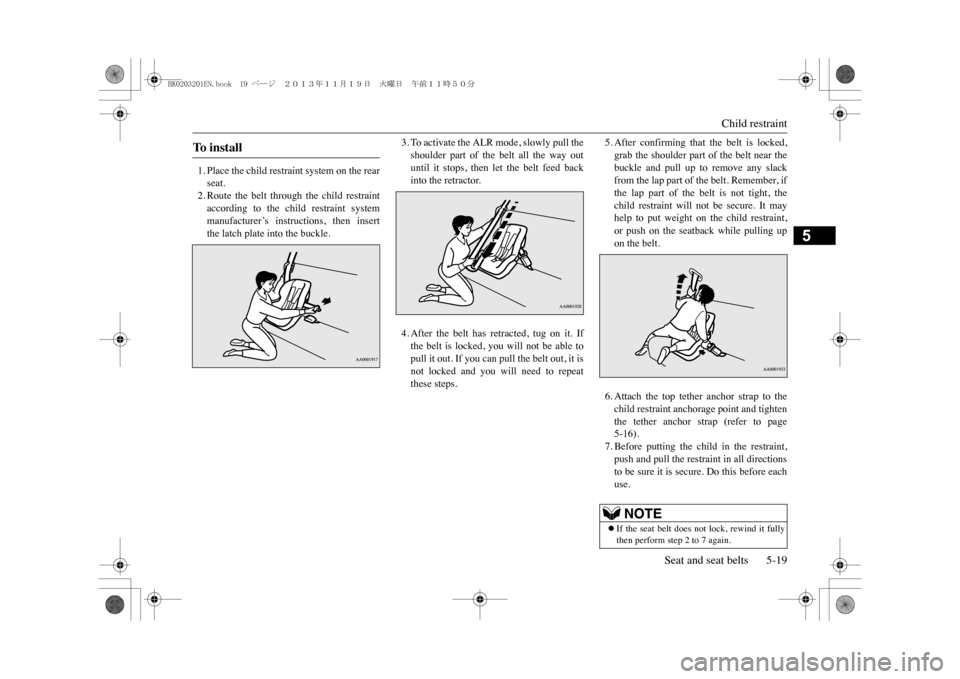
Child restraint
Seat and seat belts 5-19
5
1. Place the child restraint system on the rearseat.2. Route the belt through the child restraintaccording to the child restraint systemmanufacturer’s instructions, then insertthe latch plate into the buckle.
3. To activate the ALR mode, slowly pull theshoulder part of the belt all the way outuntil it stops, then let the belt feed backinto the retractor. 4. After the belt has retracted, tug on it. Ifthe belt is locked, you will not be able topull it out. If you can pull the belt out, it isnot locked and you will need to repeatthese steps.
5. After confirming that the belt is locked,grab the shoulder part of the belt near thebuckle and pull up to remove any slackfrom the lap part of the belt. Remember, ifthe lap part of the belt is not tight, thechild restraint will not be secure. It mayhelp to put weight on the child restraint,or push on the seatback while pulling upon the belt.6. Attach the top tether anchor strap to thechild restraint anchorage point and tightenthe tether anchor strap (refer to page5-16).7. Before putting the child in the restraint,push and pull the restraint in all directionsto be sure it is secure. Do this before eachuse.
To i n s t a l l
NOTE
�zIf the seat belt does not lock, rewind it fullythen perform step 2 to 7 again.
BK0203201EN.book 19 ページ 2013年11月19日 火曜日 午前11時50分
Page 99 of 388
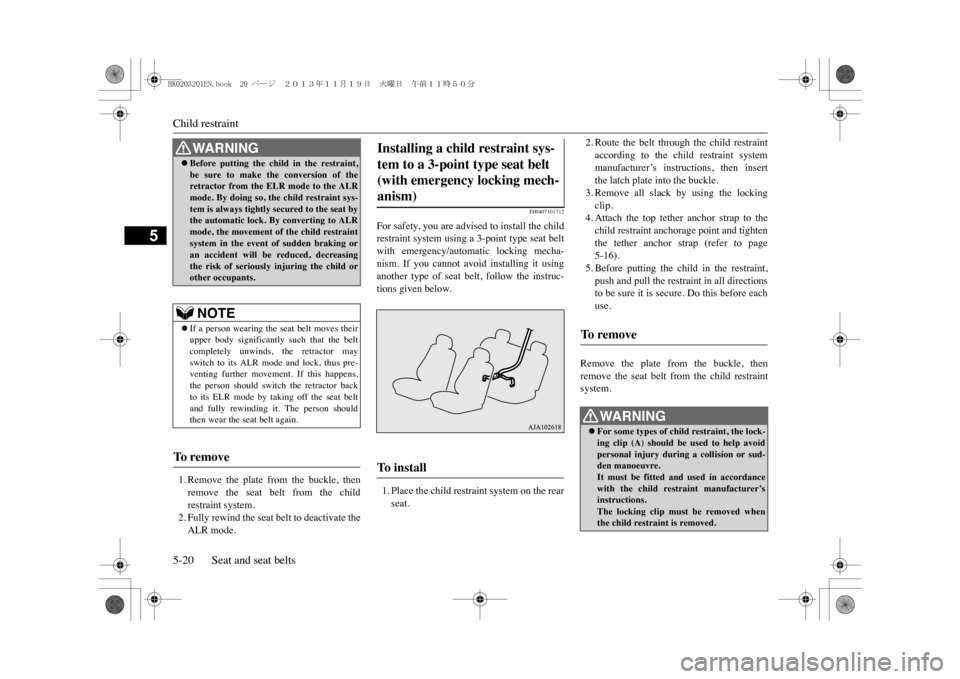
Child restraint5-20 Seat and seat belts
5
1. Remove the plate from the buckle, thenremove the seat belt from the childrestraint system.2. Fully rewind the seat belt to deactivate theALR mode.
E00407101712
For safety, you are advised to install the childrestraint system using a 3-point type seat beltwith emergency/automatic locking mecha-nism. If you cannot avoid installing it usinganother type of seat belt, follow the instruc-tions given below.1. Place the child restraint system on the rearseat.
2. Route the belt through the child restraintaccording to the child restraint systemmanufacturer’s instructions, then insertthe latch plate into the buckle.3. Remove all slack by using the lockingclip.4. Attach the top tether anchor strap to thechild restraint anchorage point and tightenthe tether anchor strap (refer to page5-16).5. Before putting the child in the restraint,push and pull the restraint in all directionsto be sure it is secure. Do this before eachuse.
Remove the plate from the buckle, thenremove the seat belt from the child restraintsystem.
WA R N I N G�zBefore putting the child in the restraint,be sure to make the conversion of theretractor from the ELR mode to the ALRmode. By doing so, the child restraint sys-tem is always tightly secured to the seat bythe automatic lock. By converting to ALRmode, the movement of the child restraintsystem in the event of sudden braking oran accident will be reduced, decreasingthe risk of seriously injuring the child orother occupants.NOTE
�zIf a person wearing the seat belt moves theirupper body significantly such that the beltcompletely unwinds, the retractor mayswitch to its ALR mode and lock, thus pre-venting further movement. If this happens,the person should switch the retractor backto its ELR mode by taking off the seat beltand fully rewinding it. The person shouldthen wear the seat belt again.
To r e m o v e
Installing a child restraint sys-tem to a 3-point type seat belt (with emergency locking mech-anism) To i n s t a l l
To r e m o v e
WA R N I N G�zFor some types of child restraint, the lock-ing clip (A) should be used to help avoidpersonal injury during a collision or sud-den manoeuvre.It must be fitted and used in accordancewith the child restraint manufacturer’sinstructions.The locking clip must be removed whenthe child restraint is removed.
BK0203201EN.book 20 ページ 2013年11月19日 火曜日 午前11時50分
Page 101 of 388
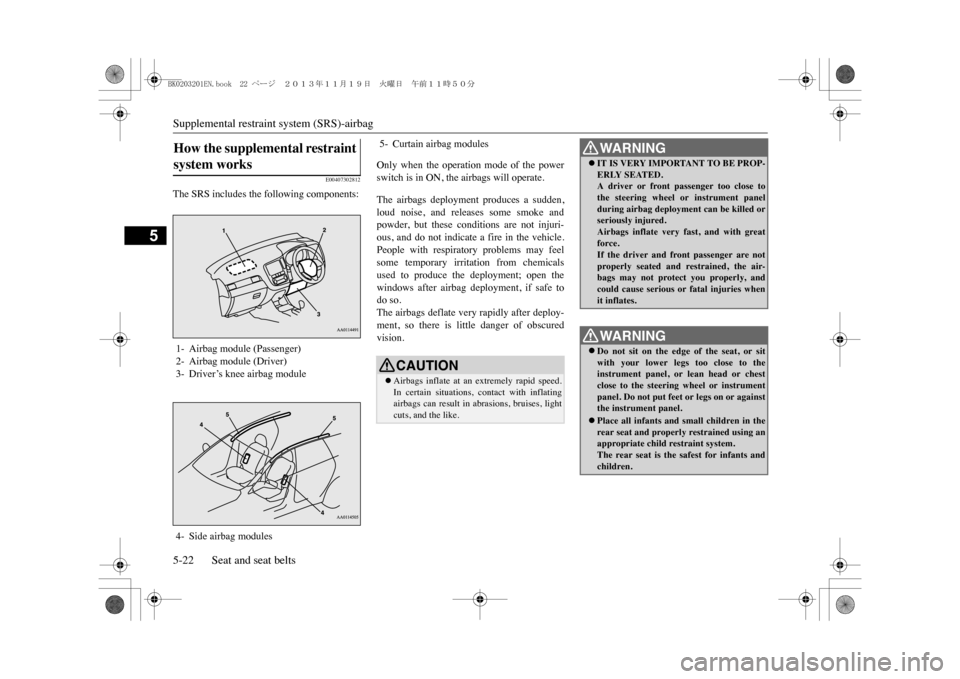
Supplemental restrain
t system (SRS)-airbag
5-22 Seat and seat belts
5
E00407302812
The SRS includes the following components:
Only when the operation mode of the powerswitch is in ON, the airbags will operate.The airbags deployment produces a sudden,loud noise, and releases some smoke andpowder, but these conditions are not injuri-ous, and do not indicate a fire in the vehicle.People with respiratory problems may feelsome temporary irritation from chemicalsused to produce the deployment; open thewindows after airbag deployment, if safe todo so.The airbags deflate very rapidly after deploy-ment, so there is little danger of obscuredvision.
How the supplemental restraint system works 1- Airbag module (Passenger)2- Airbag module (Driver)3- Driver’s knee airbag module4- Side airbag modules
5- Curtain airbag modules
CAUTION�zAirbags inflate at an extremely rapid speed.In certain situations, contact with inflatingairbags can result in abrasions, bruises, lightcuts, and the like.
WA R N I N G�zIT IS VERY IMPORTANT TO BE PROP-ERLY SEATED.A driver or front passenger too close tothe steering wheel or instrument panelduring airbag deployment can be killed orseriously injured.Airbags inflate very
fast, and with great
force.If the driver and front passenger are notproperly seated and restrained, the air-bags may not protect you properly, andcould cause serious or fatal injuries whenit inflates.WA R N I N G�zDo not sit on the edge
of the seat, or sit
with your lower legs too close to theinstrument panel, or lean head or chestclose to the steering wheel or instrumentpanel. Do not put feet or legs on or againstthe instrument panel.�zPlace all infants and small children in therear seat and properly restrained using anappropriate child restraint system.The rear seat is the safest for infants andchildren.
BK0203201EN.book 22 ページ 2013年11月19日 火曜日 午前11時50分
Page 102 of 388
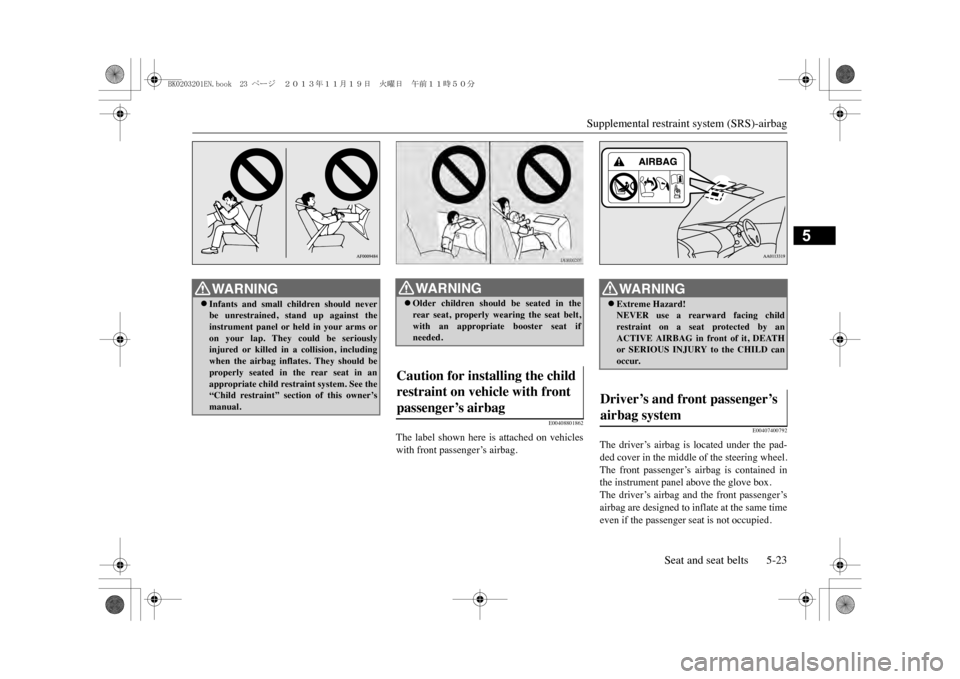
Supplemental restraint system (SRS)-airbag
Seat and seat belts 5-23
5
E00408801862
The label shown here is attached on vehicleswith front passenger’s airbag.
E00407400792
The driver’s airbag is located under the pad-ded cover in the middle of the steering wheel.The front passenger’s airbag is contained inthe instrument panel above the glove box.The driver’s airbag and the front passenger’sairbag are designed to inflate at the same timeeven if the passenger seat is not occupied.
WA R N I N G�zInfants and small children should neverbe unrestrained,
stand up against the
instrument panel or held in your arms oron your lap. They could be seriouslyinjured or killed in a collision, includingwhen the airbag inflat
es. They should be
properly seated in the rear seat in anappropriate child restraint system. See the“Child restraint” section of this owner’smanual.
WA R N I N G�zOlder children should be seated in therear seat, properly wearing the seat belt,with an appropriate booster seat ifneeded.
Caution for installing the child restraint on vehicle with front passenger’s airbag
WA R N I N G�zExtreme Hazard!NEVER use a rearward facing childrestraint on a seat protected by anACTIVE AIRBAG in front of it, DEATHor SERIOUS INJURY to the CHILD canoccur.
Driver’s and front passenger’s airbag system
BK0203201EN.book 23 ページ 2013年11月19日 火曜日 午前11時50分
Page 108 of 388
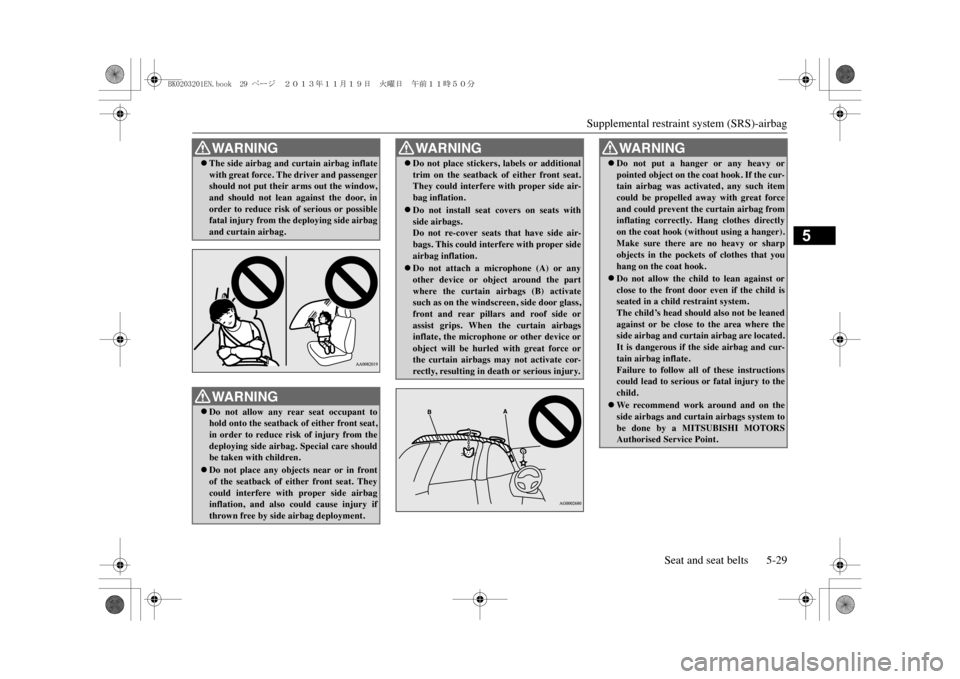
Supplemental restraint system (SRS)-airbag
Seat and seat belts 5-29
5
�zThe side airbag and cu
rtain airbag inflate
with great force. The driver and passengershould not put their arms out the window,and should not lean against the door, inorder to reduce risk of serious or possiblefatal injury from the
deploying side airbag
and curtain airbag.WA R N I N G�zDo not allow any rear seat occupant tohold onto the seatback
of either front seat,
in order to reduce risk of injury from thedeploying side airbag. Special care shouldbe taken with children.�zDo not place any objects near or in frontof the seatback of either front seat. Theycould interfere with proper side airbaginflation, and also could cause injury ifthrown free by side airbag deployment.WA R N I N G
�zDo not place stickers, labels or additionaltrim on the seatback of either front seat.They could interfere with proper side air-bag inflation.�zDo not install seat covers on seats withside airbags.Do not re-cover seats
that have side air-
bags. This could interfere with proper sideairbag inflation.�zDo not attach a microphone (A) or anyother device or object around the partwhere the curtain airbags (B) activatesuch as on the windsc
reen, side door glass,
front and rear pillars and roof side orassist grips. When
the curtain airbags
inflate, the microphone or other device orobject will be hurled with great force orthe curtain airbags may not activate cor-rectly, resulting in death or serious injury.WA R N I N G
WA R N I N G�zDo not put a hanger or any heavy orpointed object on the
coat hook. If the cur-
tain airbag was activated, any such itemcould be propelled away with great forceand could prevent the curtain airbag frominflating correctly. Hang clothes directlyon the coat hook (without using a hanger).Make sure there are no heavy or sharpobjects in the pockets of clothes that youhang on the coat hook.�zDo not allow the child
to lean against or
close to the front door even if the child isseated in a child restraint system.The child’s head should
also not be leaned
against or be close to the area where theside airbag and curtai
n airbag are located.
It is dangerous if the side airbag and cur-tain airbag inflate.Failure to follow all of these instructionscould lead to serious or fatal injury to thechild.�zWe rec ommend wor k around and on theside airbags and curtain airbags system tobe done by a MITSUBISHI MOTORSAuthorised Service Point.
BK0203201EN.book 29 ページ 2013年11月19日 火曜日 午前11時50分